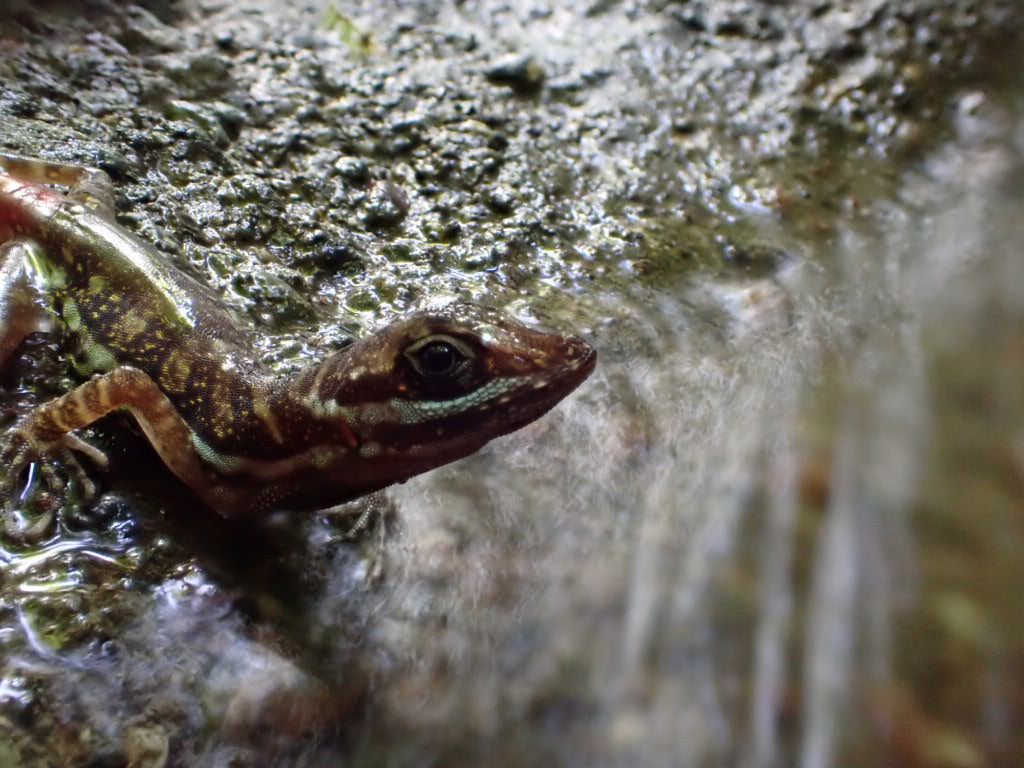Research explores the cooling effects of ‘scuba-diving’ in lizards
Strategy to hide from predators can cause up to a 6°C drop in body temperature, representing an ‘optimization problem’ for diving lizards

Anoles are the scuba-diving champions of the lizard world, able to stay underwater for more than 16 minutes. For animals whose body temperature depends on the environment, time spent in a cool running stream can have some tradeoffs.
A recent study by Binghamton University doctoral candidate Alexandra M. Martin, Christopher K. Boccia of Queens University in Canada, and Binghamton University Assistant Research Professor of Biological Sciences Lindsey Swierk explores the balance between behavioral needs and physiological costs. “Diving behavior in semi-aquatic Anolis lizards results in heat loss with sex-specific cooling tolerance” recently appeared in Behavioral Ecology and Sociobiology.
The three worked together on a 2021 paper in Current Biology, which established that the small South American lizards form a bubble of air over their noses as they dive and use it to breathe underwater. While their first line of defense is to run away on land, they will dive underwater to evade continued pursuit against predators — or researchers, said Martin, the lead author of the most recent article.
On average, the researchers discovered that male anoles stayed underwater for 20 fewer seconds than females. However, actual dive times and sex differences could be greater in the field, given the stress of predation and the cool temperatures of the flowing water in their habitat.
“This may not sound like very much, but biologically, 20 seconds could easily be the difference between life and death,” Martin pointed out. “A hungry bird may decide that searching for an extra 20 seconds simply isn’t worth the energy it might cost and would rather search for better luck downstream.”
Diving, however, comes at a cost: up to a 6°C drop in body temperature. Reptiles are ectotherms which rely on their external environment to maintain body temperature. Remaining in cool water can potentially affect a range of bodily functions, including muscle function — critical for escaping predation.
Recouping body heat isn’t easy for anoles, either. Temperatures are mild at the researchers’ higher-elevation study sites in Costa Rica, with an average day at around 70 degrees Fahrenheit.
“Semi-aquatic anoles seem to have evolved a sex-specific tradeoff between finding safety underwater and retaining body heat on land. This represents what behavioral ecologists call an ‘optimization problem,’ where animals have to balance the costs and benefits of performing particular behaviors,” Swierk said.
In their study, the researchers didn’t find any evidence of sex differences in oxygen consumption, which suggests that other factors drive the sex difference in dive times, Swierk said.
In species such as Anolis aquaticus, males are the showier sex while females are the choosier sex, Martin explained. Females invest more energy in producing offspring, whereas males spend more on courtship and mating. By shortening their dives, males conserve body heat and physiological capacity, which may minimize the “time out” period, as their muscles recover from the cool water.
Longer dives, however, mean that it’s less likely for a predator to be waiting once the anole returns to the surface. Females appear to trade the physiological cost of cool water for that extra safety, since they don’t face the same pressure as males to look for eligible mates or defend territory.
Like little scuba divers, anoles maintain a “dry suit” of air underwater, which may help them retain some heat. The researchers plan to explore the function and mechanisms of this trait and others more fully in future research, Swierk said.
“The ways that animals can adapt to environmental pressures are astounding and have continued to inspire humans to push the boundaries of bio-inspired design,” Swierk said. “We are curious and excited to explore these ideas in the future.”
